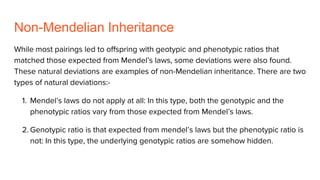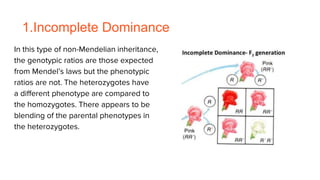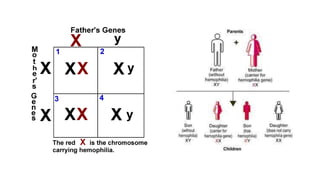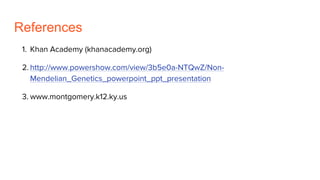Non-Mendelian Inheritance
- 2. Mendelian Inheritance The process of genetic transmission of traits from parents to offspring is called inheritance. It is also defined as the sum of the characteristics genetically transmitted from parents to offspring. Mendelian Inheritance is that which follows MendelŌĆÖs laws. MendelŌĆÖs laws are as follows:- 1. Principle of segregation: A given pair of alleles segregate randomly when gametes are formed. 2. Law of independent assortment: Each pair of alleles will assort independently and randomly from every other pair of alleles.
- 3. Non-Mendelian Inheritance While most pairings led to offspring with geotypic and phenotypic ratios that matched those expected from MendelŌĆÖs laws, some deviations were also found. These natural deviations are examples of non-Mendelian inheritance. There are two types of natural deviations:- 1. MendelŌĆÖs laws do not apply at all: In this type, both the genotypic and the phenotypic ratios vary from those expected from MendelŌĆÖs laws. 2. Genotypic ratio is that expected from mendelŌĆÖs laws but the phenotypic ratio is not: In this type, the underlying genotypic ratios are somehow hidden.
- 4. 1.Incomplete Dominance In this type of non-Mendelian inheritance, the genotypic ratios are those expected from MendelŌĆÖs laws but the phenotypic ratios are not. The heterozygotes have a different phenotype are compared to the homozygotes. There appears to be blending of the parental phenotypes in the heterozygotes.
- 5. 2. Codominance Codominance is the phenomenon in which both alleles of a gene pair are expressed in the phenotype of the organism. Codominance is best explained using an example. The most common instance of codominance is the genetic coding of human blood groups. Human blood group phenotypes are controlled by genes that have three different allelic forms: IA, IB and i. The IA and IB alleles are codominant while the i allele is recessive. The possible genotype/phenotype combinations are: IAIA/type A, IBIB/type B, IAIB/type AB and ii/type O. This is because the IA allele codes for A antigens on the surfaces of the red blood cells, IB codes for B antigens on the surfaces of the red blood cells and i does not code for any antigens.
- 6. Another common example of codominance is that of the coloration of Rhododendron flowers. The homozygous dominant gene pair gives rise to the red phenotype, the homozygous recessive gene pair gives rise to the white phenotype and the heterozygous pairing gives rise to the pink phenotype, which is a clear case of blending of the parental traits.
- 7. 3. Multiple alleles/Polygenic Inheritance This is the phenomenon by which a single trait is controlled by multiple alleles and has many possible phenotypes. Traits that are passed down in this manner are also under the influence of environmental factors such as photoperiod and duration of day etc. Some common examples of this type of inheritance are human blood groups (which has been outlined earlier), height and eye color in humans and fur color in animals.
- 9. 4. Linked traits Traits passed down by this method of inheritance are those coded by genes which are located close to each other on the same chromosome. This is due to genetic linkage. Genetic linkage is defined as the tendency of DNA sequences that are close together on a chromosome to be inherited together during the meiosis phase of sexual reproduction. A very common instance of linked traits is the combination of red hair, fair skin and freckles in humans.
- 10. Sex-linked traits This is a type of linked trait inheritance in which the linked traits have genes that have their loci on the same sex (X or Y) chromosome.
- 11. Hemophilia The inheritance of hemophilia is a good example of sex-linked inheritance. Hemophilia is a recessive sex-linked trait that affects only males while females in the family tree are generally carriers of the disease or of the normal phenotype. This is because the gene that codes for hemophilia is present only on the X chromosome. In heterozygous females, the disorder is not expressed as it is a recessive disorder and the so, the other normal X chromosome will be expressed. However, in males with a XC chromosome, the disorder will be expressed as the gene pair for the affected X chromosome will be a Y chromosome which does not have the normal gene to dominate over the affected X chromosome. In this way, hemophilia is passed down by the females of a bloodline and expressed usually in males.
- 14. References 1. Khan Academy (khanacademy.org) 2. http://www.powershow.com/view/3b5e0a-NTQwZ/Non- Mendelian_Genetics_powerpoint_ppt_presentation 3. www.montgomery.k12.ky.us













